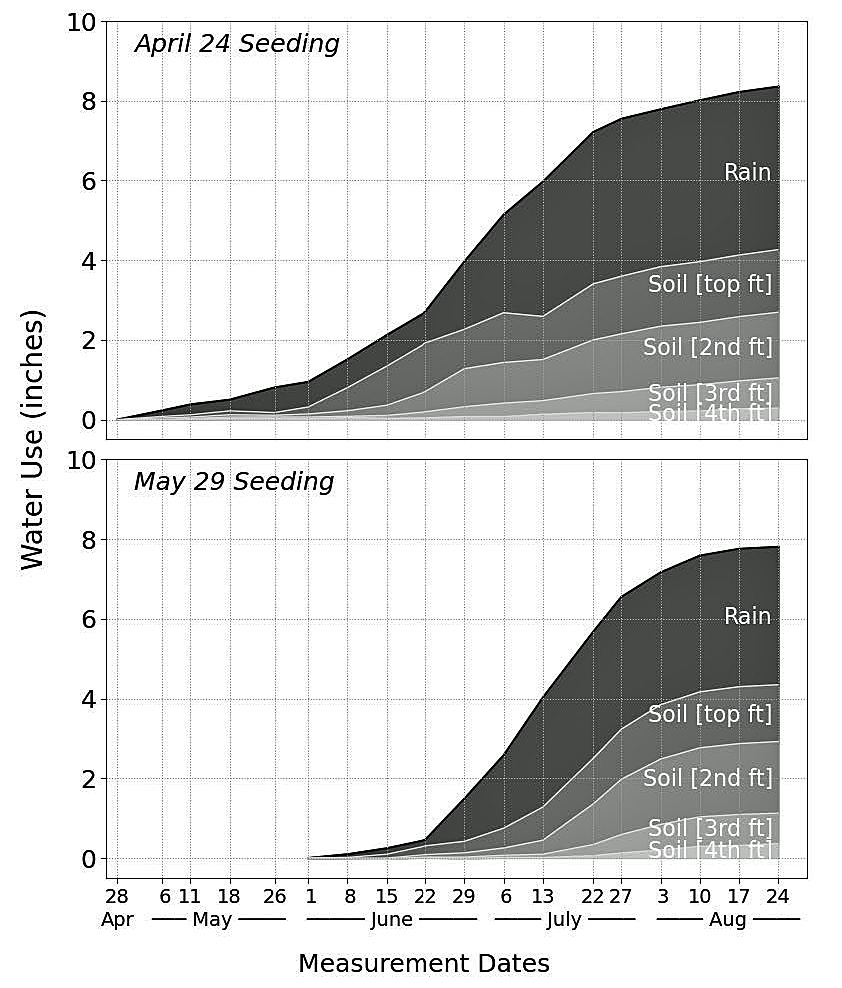Greater than normal precipitation occurred in September 2019, resulting in ample soil moisture at the start of the 2020 growing season. However, only 4.15 inches of rain occurred between April 24 and August 24. Crop water use was greatest for flax planted on April 24 and decreased fairly steadily as the seeding date was delayed (Table 1). This decrease was primarily due to rainfall missed by delayed seeding. However, the amount and the fraction of water obtained from the soil increased for the last two seeding dates (Table 1) suggesting a compensation for decreased rainfall. As seeding date was delayed, the fractional decrease in water use was less than the fractional decrease in growing season length, so that the water use per week increased as seeding date was delayed (Table 1).
Table 1: Crop water use amount, source, and rate; and water use efficiency.
| Seeding date |
Crop water use |
Water from rain |
Water from soil |
Pct. of water from soil |
Water use per week |
Yield |
Water use efficiency |
| 4/24/2020 |
8.36 in. |
4.09 in. |
4.27 in. |
51% |
0.50 in. |
19.7 bu/a |
2.4 bu/in |
| 5/1/2020 |
7.97 in. |
3.94 in. |
4.03 in. |
51% |
0.50 in. |
21.8 bu/a |
2.7 bu/in |
| 5/8/2020 |
7.78 in. |
3.83 in. |
3.95 in. |
51% |
0.52 in. |
23.4 bu/a |
3.0 bu/in |
| 5/15/2020 |
7.86 in. |
3.81 in. |
4.05 in. |
52% |
0.56 in. |
22.8 bu/a |
2.9 bu/in |
| 5/22/2020 |
7.82 in. |
3.46 in. |
4.36 in. |
56% |
0.61 in. |
22.5 bu/a |
2.9 bu/in |
| 5/29/2020 |
7.81 in. |
3.46 in. |
4.35 in. |
56% |
0.65 in. |
19.2 bu/a |
2.5 bu/in |
Daily water use increased greatly after June 22 for all seeding dates.
Figure 1: Accumulative crop water use, partitioned by source. (Data presented only for the first and last seeding dates, 4/24/2020 and 5/29/2020).
This was the first time water use exceeded 0.1 inch per day for any of the treatments. Water use remained greater than 0.1 inch per day until July 22 for all seeding dates. After July 22, daily water use decreased to less than 0.1 inch per day for the first three seeding dates, however, daily water use by the last three seeding dates remained greater than 0.1 inch per day for one week longer. There did not appear to be sufficient differences in the soil water content among the seeding dates to account for the earlier decrease in water use by the earlier seeding dates. The decreased water use after July 22 for the first three seeding dates was likely due to the crop reaching maturity whereas the later seeding dates had not.
Daily water use was influenced much more by calendar date than by the number of days after seeding. All seeding dates had water use exceeding 0.1 inch per day between the June 22 and July 22 measurement dates, even though this was 59 to 89 days after seeding for the first seeding date and only 24 to 54 days after seeding for the last seeding date. This suggests that daily water use may be influenced more by weather conditions than by crop growth stage.
Flax yield first increased then decreased as seeding date was delayed (Table 1). Water use efficiency, in terms of bushels produced per inch of water used, followed a similar trend (Table 1).
The 2020 growing season was a drought year, with only 4.09 inches of rain between April 24 and August 24, the starting and ending dates of this study. The drought not only reduced the flax yield, it undoubtedly affected the water use patterns presented in this report. Greater rainfall likely would decrease the fraction of water obtained from the soil. However, greater rainfall also likely would have increased crop growth and thus increased water use, so that the amount of water obtained from the soil may have been similar to the amounts observed this year.
Other research conducted at the Williston Research Extension Center has found that, in the majority of years, spring wheat depletes all plant available water in the upper three feet of soil by the end of the growing season. This happens regardless of the soil moisture level at the beginning of the growing season and occurs every year except for those with extremely rainy growing seasons. This suggests that the patterns of soil water use by wheat also may not be affected by seeding date.
Soil water use by various crops and how it is influenced by crop management practices will remain an on-going research topic at the Williston Research Extension Center.

